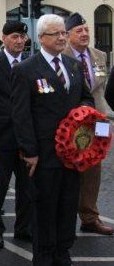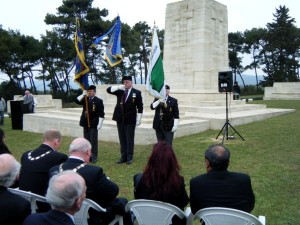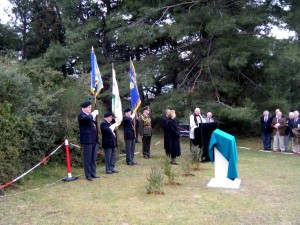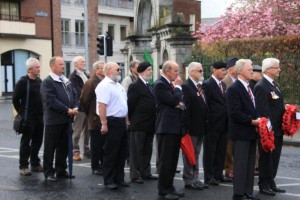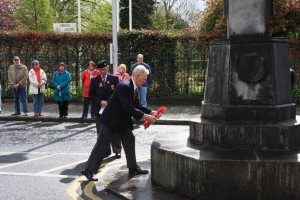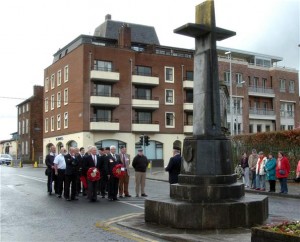John Joseph Cleary was born on the 27th December 1893 in the town of Listowel, situated on the River Feale in North County Kerry. The son of a sergeant in the Royal Irish Constabulary, he was one of fourteen children, five boys and nine girls. Cleary joined the Munsters in 1912 and was assigned to the 2nd Battalion with regimental number 9834. On the outbreak of war in Memorial Cross at the August 1914, he was a Lance Corporal and attached to C Company, at that time stationed at Malplaquet Barracks, Aldershot, Hampshire.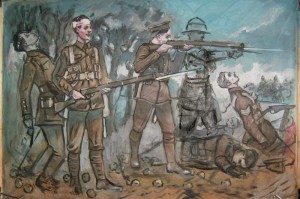
Author Archives: admin
Schull Books
Schull Books, Ballydehob, Co Cork. Tel and Fax: 028 37317 - International + 353 28 7317
Rue du Bois 8th May 1915
There are many journeys and many stopping-places in the strange pilgrimage we call life but there is no other such journey in the world as the journey up a road on the eve of battle and no stopping-place more holy than a wayside shrine (Mrs. J. Rickard)
These pages are on the subject of the Last Absolution administered to the 2nd battalion Munster Fusiliers by the Rev. F. Gleeson on 8th May 1915 at Rue du Bois. Namely a brief history of the painting followed by directions to the location of the event.
Continue reading
10th Irish Division at Gallipoli
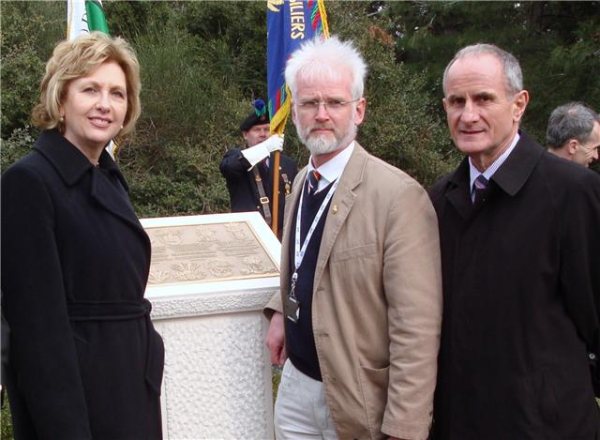
Mr. Michael Lee, centre, with the President and her husband at the recent unveiling of the memorial to the 10th Irish Division at Gallipoli. Mr. Lee is a member of the Royal Munster Fusiliers Association.
President McAleese’s visit to Gallipoli: On the 24th March 2010, President Mary McAleese visited Gallipoli to commemorate over 3,000 Irish soldiers who died in the British Army in WWI.
The President said she hopes a joint British-Irish commemoration to mark the Gallipoli landings will be possible on the centenary of the engagement in five years’ time.
She was speaking during a visit to a cemetery there where many Irish remains lie.
Mrs McAleese fulfilled a number of engagements including a visit to the Turkish monument, a ceremony at the memorial to British and Irish soldiers who died, and a dedication of a commemorative plinth (see photo) at another graveyard.
“Gallipoli Fallen Remembered in Limerick” article by Major Brian Duffy (Left)
(Image to Left): Major Duffy, V/President Royal British Legion, Limerick, at the Gallipoli commemoration in Limerick, April 25, 2010. NB:Image is actual size
Speaking at V beach, where many Irish perished in an abortive landing, the President said that those who fell at Gallipoli were doubly disadvantaged; they were shunned at home for having worn the British uniform and their sacrifice was forgotten because they had been associated with defeat.
This was the first official recognition by the State of Irish involvement in the Gallipoli landings.
It is estimated that over 3,000 Irish soldiers died out of a total of 44,000 on the allied side in WWI.
They died over six months in 1915 in a failed attempt by the Allies - whose key members included Britain, France and the Russian Empire - to secure the approaches to Istanbul and the Black Sea.
Some 80,000 Turkish soldiers lost their lives in the campaign.
The visit had been a long time coming for those who have been campaigning for the recognition of the role played by Irish soldiers in the British Army. RTE News
The banners of the Royal Munster Fusiliers Association (carried by Mr. Neil Leinster) and Royal Dublin Fusiliers Association (carried by Mr. Seamus Green) along with the banner of the 10th Irish Division were on parade.
The Royal Munster Fusiliers Association commemoration at Limerick on April 25, 2010, in honour of the Irishmen who fell at Gallipoli.
 This is the actual area where the Last General Absolution of the 2nd Battalion RMF, (as depicted in Matania’s famous painting), took place on May 8, 1915. The sign itself is only a temporary one and it is hoped that, with the help of some friends of the RMFA in France, a permanent sign can be fixed on the spot. The wall enclosed the area where the 2nd Battalion formed up for the ceremony and beyond lay the area of the ensuiing battle of Aubers Ridge.
This is the actual area where the Last General Absolution of the 2nd Battalion RMF, (as depicted in Matania’s famous painting), took place on May 8, 1915. The sign itself is only a temporary one and it is hoped that, with the help of some friends of the RMFA in France, a permanent sign can be fixed on the spot. The wall enclosed the area where the 2nd Battalion formed up for the ceremony and beyond lay the area of the ensuiing battle of Aubers Ridge.
EXTRACT JOURNAL NO 7 AUTUMN 1995
LIEUTENANTS JOSEPH BAGNALL LEE AND ALFRED TENNYSON LEE AND THE 6TH BATTALION ROYAL MUNSTER FUSILIERS AT SUVLA BAY GALLIPOLI AUGUST 1915.
THE WAR SERVICE Of JAMES MEEHAN. 7460. Sgt R.M.F.
BY MARTIN STAUNTON.
JAMES MEEHAN WAS BORN ON THE 16th OCTOBER 1884 AND ENLISTED IN HIS HOME TOWN OF LIMERICK ON THE 16th MARCH 1903 AND EVENTUALLY SERVED WITH THE Ist MUNSTERS IN INDIA BEFORE LEAVING THE THE ARMY IN 1911.
LIMERICK SOLDIERS TRIBUTE TO BRAVE IRISH PRIEST
RESEARCH, T.MOLONEY.
LETTER FROM THE FRONT (LIMERICK LEADER WEDNESDAY EVENING MAY 19TH 1915). THIS MORNING’S POST BROUGHT US THE FOLLOWING LETTER. WRITTEN IN HOSPITAL AND DATED MAY 15TH. FROM PRIVATE J DANAHER. A LIMERICK MAN IN THE 2ND R.M.FUSILIERS. NOW WITH THE BRITISH EXPEDITIONARY FORCES IN FRANCE:-


